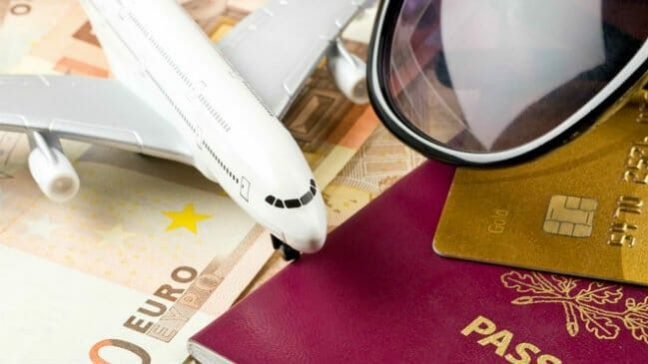Whenever you use your credit card to buy things in another country or to make an online purchase from an internationally-based merchant, you might pay a foreign transaction fee. Foreign transaction fees are charged by your credit card issuer or bank to cover the costs of converting your purchase into U.S. dollars.
These fees are annoying, to say the least, and they can quickly get expensive and put a damper on an otherwise fun and carefree trip. But with a few tricks, you never have to pay a foreign transaction fee again.
Learn more about how foreign transaction fees are charged and how to avoid them every time you travel.
What are foreign transaction fees?
Foreign transaction fees, often written as fx fees, are fees you pay your credit card company, bank, or credit union every time you make a purchase outside of the U.S. or buy something online from an international company. If the transaction has to go through a foreign bank before it can be processed in the U.S., it will probably come with this fee.
Foreign transaction fees are usually between 1% and 4% with the average at around 3%, but every card issuer and bank is different. This fee is charged as a percentage of your transaction after it’s been converted to U.S. dollars and billed separately from your international purchases. So if you’re buying something that costs $10 and your foreign transaction fee is 3%, the price after fees would be $10.30.
Sometimes, foreign transaction fees are flat fees such as $1 or $2 for every purchase, but this is less common. You should always know what foreign transaction fee your credit card charges and how it’s calculated, even if you don’t travel a lot.
You’ll usually see foreign transactions listed on your bank or credit card statement as separate charges from the purchases that trigger them. They may not appear instantly.
Some banks also charge foreign transaction fees when you use your debit card to make ATM withdrawals internationally. These are on top of other ATM fees such as out-of-network fees and processing fees, so withdrawing cash to avoid foreign fees is not a good strategy.
International transaction fees can add up if you’re traveling and putting everything on your credit card. But luckily, they can be avoided pretty easily.
Foreign transaction fees vs. conversion fees
Foreign transaction fees are not the same thing as currency conversion fees.
Currency conversion fees or currency exchange fees are charged by payment processing networks — like Mastercard, Visa, and American Express — when you make foreign transactions, not your credit card issuer. A currency conversion fee is included as part of your total foreign transaction fee and is usually equal to around 1%. If the foreign transaction fee is waived for your card or account, the conversion fee likely is too.
International merchants may also charge their own currency conversion fees. If this is the case, there’s not much you can do about it except avoid paying more than you need to — and be aware of traps like Dynamic Currency Conversion.
If you’re using your credit card while traveling abroad and a merchant gives you the option to charge the purchase to U.S. dollars as you’re checking out, don’t take it. This is a service called Dynamic Currency Conversion and while it might sound like a good way to dodge foreign transaction fees, it’s not. It costs extra because point-of-sale conversions come with an unfavorable exchange rate (up to 7%). Plus, you’ll still incur foreign transaction fees from your credit card issuer, so it’s really a lose-lose situation for you all around.
Instead, charge your purchases to the local currency if a card reader gives you the option. The transaction will be processed in that currency and converted to USD after it goes through, then you’ll only pay a foreign transaction fee (or not…).
How to avoid foreign transaction fees
There are a few tried-and-true strategies you can use to avoid foreign transaction fees every time you travel. Try these out the next time you’re in another country.
Use a fee-free credit card
One of the best, easiest, and safest ways to get out of paying foreign transaction fees is to just use a credit card that doesn’t charge them. Most major issuers offer at least a couple of credit cards with no foreign transaction fees, some that come with annual fees and some without. This is usually listed as a perk and is most common with travel rewards cards.
Often, if a card waives foreign transaction fees, it probably comes with extra travel benefits too. This can include travel insurance, global concierge lines, rewards program membership with hotels and airlines, and more. These cards also offer the highest rewards and cashback rates when you travel, and you can use those points to save money on future flights, hotel bookings, and car rentals.
Credit cards are also safer than debit cards or cash because they come with fraud protection. If your credit card is lost or stolen and used to make purchases you didn’t authorize, you won’t be responsible for the costs.
Here are a few of our favorite credit cards that don’t charge foreign transaction fees.
Chase Sapphire Preferred® Card
The Chase Sapphire Preferred® Card is one of the best credit cards you can get for traveling, and not just because it doesn’t come with a foreign transaction fee.
This credit card earns:
- Five points per dollar on all travel purchases made through Chase Ultimate Rewards®
- Two points per dollar on all other travel purchases
- Three points per dollar on dining, online grocery purchases, and select streaming services
- One point per dollar on everything else
Plus, you’ll get a $50 Chase Ultimate Rewards® hotel credit each year and 1:1 point transfer to partner airlines and hotel brands. We like this card for people who want points flexibility because the Chase rewards program offers so many different options for redemption.
There is an annual fee of $95 for this card, but if you travel often, it’s definitely worth paying for. You need excellent credit to qualify.
Capital One Venture Rewards Credit Card
The Capital One Venture Rewards Credit Card is the perfect card for anyone looking to earn miles instead of rewards points. This credit card earns 5 miles per dollar on hotels and rental cars booked through Capital One Travel and 2 miles per every dollar you spend on everything else, with no points cap.
It also includes a $100 credit for Global Entry and TSA PreCheck® and two free lounge visits per year through the Partner Lounge Network.
And of course, it doesn’t charge a foreign transaction fee. You can use your miles to book travel including flights, hotel stays, rental cars, and more. This card is best for people who fly a lot.
Like the Chase Sapphire Preferred® Card, you need excellent credit to qualify and there’s an annual fee of $95. But with the Global Entry credit alone, this fee pays for itself. Excellent credit is needed for this credit card as well.
Capital One Quicksilver Cash Rewards Credit Card
If you don’t want to pay an annual fee and/or don’t have an excellent credit score, you probably want to check out the Capital One Quicksilver Cash Rewards Credit Card. This card earns 5% cash back on hotels and rental cars booked through Capital One Travel and 1.5% cash back on all other purchases.
Because this card is pretty much a travel and rewards credit card combined, it’s ideal for everyday purchases and shopping online but will also come in handy when you do travel abroad.
Besides no foreign transaction fee, there aren’t a lot of other benefits for this card, but it does come with price protection and extended warranty benefits. A credit score in at least the good range is required to qualify, and you can find out if you’re pre-approved without affecting your credit.
Use a fee-free debit card
If you’re not comfortable charging everything to credit cards when traveling, a debit card that doesn’t charge foreign transaction fees is another option. Many banks waive foreign transaction fees for certain checking accounts, so you can use the linked debit card just as you would a credit card to avoid fees.
Opening a free checking account with no minimums before your next trip is a smart move. Look for one with waived foreign transaction fees.
Although debit cards do come with some risks — they don’t carry the same level of fraud protection as credit cards, for example — they can be a little safer than carrying cash. Just make sure that if your card is lost, stolen, or otherwise compromised, you immediately contact your bank to cancel it. Identity theft takes place everywhere.
Whether you’re at home or in a new country, take steps to protect yourself when using your debit card.
Read more: Practice safe spending: How to use your debit card safely
Use local currency
We mentioned earlier that charging transactions to local currency at a card terminal can be a good way to avoid costly currency conversions, but using local currency can also help you dodge foreign transaction fees.
If you have the time, you can exchange your money for a different currency before you even leave for your trip. While you might be tempted to do this in the airport right before your flight takes off, you’ll save more by comparing rates with different vendors. The best place to go is often your local bank or credit union because they might give you a discounted exchange rate. Just don’t take out more money than you need and get stuck with an excess of foreign bills.
And if you forget to exchange currency before you leave, you might be able to find a decent currency exchange rate at a foreign ATM, but you’ll likely pay other ATM fees.
But as you probably already know, it’s not usually safe to carry a lot of cash on you when you travel, so we don’t recommend doing this for all of the money you need for your trip. While keeping at least a handful of local currency on you is recommended, carrying a lot of money as a tourist can be risky.
Read more: How to exchange foreign currency: the 3 simple rules
Avoid using ATMs
Unless you know for sure your bank doesn’t charge foreign transaction fees for international withdrawals, you’re going to want to avoid using ATMs when you’re in a different country. Withdrawing cash in a foreign country can quickly get expensive when fees from your own bank, the ATM network, and the foreign bank the ATM is through are all added.
If you absolutely need to withdraw money while in another country, maybe because a merchant won’t accept your credit card, take out as little as possible. But a lot of popular tourist destinations today do take most cards, so that shouldn’t be an issue.
Read more: The best and safest ways to manage money when you travel
Summary
A lot of banks, credit unions, and credit card companies will charge you a foreign transaction fee to cover the costs of converting a purchase from foreign currency to USD.
The next time you’re traveling abroad, make sure you have a plan for avoiding foreign transaction fees. The easiest for most people is to choose a great travel rewards card that waives the fee, but you have other options too. Do whatever works for you so you can explore without worrying about extra expenses.
For Capital One products listed on this page, some of the above benefits are provided by Visa® or Mastercard® and may vary by product. See the respective Guide to Benefits for details, as terms and exclusions apply.


